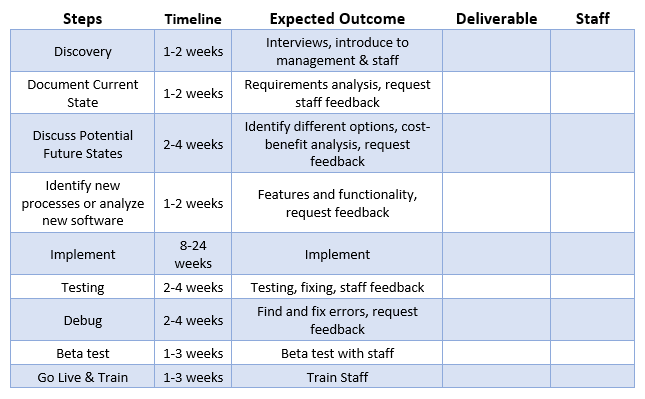- Howie Fenton
- |
- December 12, 2022
This is the third blog in a series about proactively responding to dramatic changes in the industry. In the previous two blogs, we discussed the impact of: the pandemic, staff working from home, supply change issues, and recruiting issues. Although some in-plants have been minimally impacted, others have been surprised at the speed and depth of the latest changes. The first two blogs discuss how to analyze your situation and identify and acquire the resources required. In this final blog in the series, we will discuss how to “get there”- deliver on your strategy to respond to changes- by achieving the goal of implementing potential changes to improve your sales, marketing, or operations.

The “Failed Implementation Closet”
One of the most shocking discoveries as a consultant is finding the “failed implementation closet.” Based on the name, you can probably guess that the contents are failed productivity initiatives, quality programs, or new software implementations (Web to Print, Print MIS, Prepress software). These closets are where failed implementations go to die. Every year I visit at least 1 or 2 companies with these closets and I am even more surprised that they are still paying for the maintenance contract.
The first question to consider in this process is who should be responsible for the implementation. Should you do it yourself or should you look for help from a professional (manufacturer, retailer, consultant)? Although no one wants to admit this, companies already know if they are good or bad at implementation or if they have a “failed implementation closet.” I estimate that about one-third of companies never successfully or fully implement the software they purchase. So, take a long hard look to see if you have the staff, expertise, and time to work through implementation. One way to avoid failure is to consider outside help from the manufacturer, dealer, or consultants.
If you want to implement your program or software without outside help, the most critical step in the process is a reasonable and flexible plan that holds staff and management accountable for success.
There are many good sources of information on implementation strategies, such as the Project Management Institute (PMI), the Project Management Body of Knowledge (PMBOK), Agile software development processes, and Lean and Six Sigma methodologies.
Considering the importance of change in our industry, one might expect that all companies are experts in implementation planning. Surprisingly, that is not true, and ironically the same companies that are not good at creating their own implementation plans are very good at writing detailed plans when bidding on outside work in the process known as responding to requests for proposals (RFPs) process. The RFP bidding process is how local, state, federal and commercial companies procure services, including printing.
Some of the most detailed implementation plans are in these RFP bids, which makes sense when you consider companies are bidding on millions of dollars of work. I have been fortunate to work with companies on these RFP bids and discovered that the best plans: outline all steps in the process, identify the staff who will be supervising and implementing the plan, discuss the dates of starting and ending each step, the deliverables, and provide the flexibility for change.
While the PMI PMBOK is considered the traditional model, more modern approaches are gaining popularity, such as Agile, Lean or Six Sigma methodologies. The underlying idea in many of these new planning strategies is the comparison of the current state vs. future state. The current state analysis defines what you are currently doing, including: procedures, training, and hardware/software. The future state defines how things will work after the implementation, including hardware, software, and process changes. The current vs. future state analysis measures the difference between the two states (called a gap analysis) and identifies what is missing.
How To Avoid the “Failure Closet”
Believe it or not, one of the reasons implementations fail is because there was no plan or no planning tool. A good implementation plan or process plan could be considered a “schedule on steroids”. These detailed plans include a schedule with staff and supervisor names, objectives, hurdles, workarounds, etc. Below is a generic example that can be adapted for operational process plans.

Equally important to developing an implementation plan is finding a good tool to manage the plan and track your progress. If you have someone skilled with Microsoft Excel, that can be used as a planning tool. Another inexpensive planning tool is Smartsheet. And some companies have had success with a product called Monday.com.
Regardless of the tool, the key is to build a step-by-step implementation plan such as the one provided in this blog that specifies everything you need to do, who is going to do it, who is supervising them, when it will get done, and be flexible enough to change as hurdles appear. In most spreadsheet tools, you can also build status tags such as not started, in progress, on hold, or completed.
Put it All Together and Proactively Respond to Change
Failed implementations are time-consuming and costly. Therefore, you want to avoid the failed implementation closet. Achieve your plan by determining implementation responsibility (internal or external); build a step-by-step flexible and reasonable implementation plan with accountability- ideally that identifies what is missing between the current and future states- and use a tool to manage the plan and track your progress.
While changes in the industry have been non-stop for decades, the challenges in the last few years appear faster and more significant. Use the suggestions in our blog series to provide a roadmap for researching, building the infrastructure, and implementing change. The end of the year and the beginning of next year are often slow times that can be used for researching, planning, and taking action.
Need Some Assistance?
Need some help with research, building the infrastructure to change or developing a plan to implement change? Contact RSA or Howie Fenton Consulting for help today.